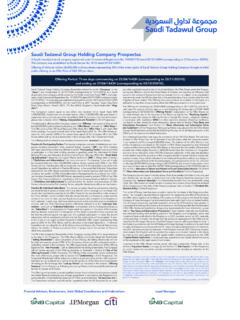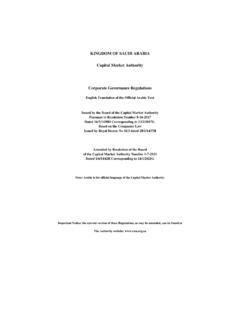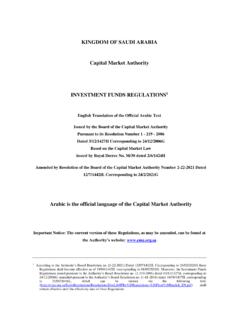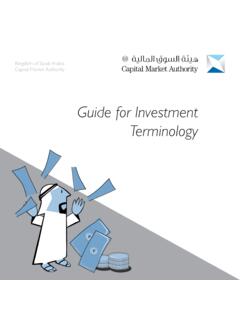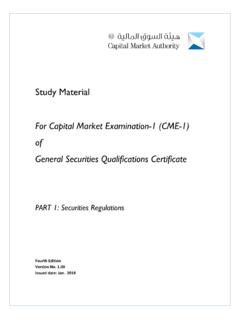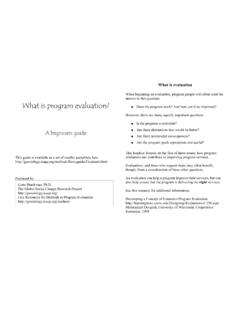Transcription of Prudential Rules - cma.org.sa
1 Prudential Rules Contents Part 1: Introduction Chapter 1: Scope, Purpose and Definitions .. 7. Part 2: capital Base Chapter 2: capital Base Requirement .. 13. Chapter 3: Composition of capital .. 13. Part 3: Pillar I Minimum capital Requirements Chapter 4: General Provisions for the Trading Book .. 17. Chapter 5: Management Requirements for the Trading Book .. 19. Chapter 6: General Provisions for non-Trading Activities .. 21. Chapter 7: Calculating a Risk-Weighted Exposure Amount for non-Trading Activities .. 21. Chapter 8: Use of Credit Ratings .. 23. Chapter 9: General Provisions Regarding Operational Risks .. 25. Chapter 10: Basic Indicator Approach for Operational Risk .. 25. Chapter 11: Standardised Approach for Operational Risk .. 25. Chapter 12: Expenditure-based Approach for Operational Risk .. 26. Chapter 13: General Provisions Regarding Foreign Exchange Rate Risk .. 27. Chapter 14:Valuation and Conversion to Local Currency .. 27. Chapter 15: Calculating the capital Requirement for Foreign Exchange Rate Risk.
2 27. Chapter 16: General Provisions Regarding Commodities Risk .. 28. Part 4: Large and Excess Exposures Chapter 17: General Provisions Regarding Large and Excess Exposures .. 33. Part 5: Minimum Liquidity Requirements Chapter 18: General Provisions Regarding Liquity Requirements .. 37. Chapter 19: Organisational Requirements .. 37. Part 6: Pillar II assessment of All Risks Chapter 20: internal capital adequacy assessment process (ICAAP) .. 43. Part 7: Pillar III Disclosure and Reporting Chapter 21: Disclosure .. 47. Chapter 22: Reporting .. 47. Part 8: Financial Groups Chapter 23: General Provisions Regarding Financial Groups .. 51. Chapter 24: Consolidated Accounts .. 51. Chapter 25: Foreign Undertakings .. 53. Chapter 26: Systems and Controls .. 53. Part 9: Closing Provisions Chapter 27: Publication and Entry into Force .. 57. Annexes Annex 1: capital Base Chapter 1:Tier-1 capital .. 61. Chapter 2:Tier-2 capital .. 64. Chapter 3: Deductions From capital .. 70.
3 Annex 2: Trading Book Chapter 1: Interest Rate Risks .. 72. Chapter 2: Equity Price Risks .. 90. Chapter 3: Risks Related to Investment Funds .. 94. Chapter 4: Underwriting .. 96. Chapter 5: Excess Exposure .. 97. Chapter 6: Settlement Risks .. 98. Chapter 7: Counterparty Risks .. 99. Annex 3: Non-Trading Activities Chapter 1: Exposure Classes and Risk Weights .. 102. Chapter 2: Calculating Exposure Amounts for off-Balance Sheet Items .. 106. Chapter 3: Calculating the non-Trading Book Exposure Amount for Derivatives .. 108. Chapter 4: Credit Protection .. 116. Chapter 5: Guarantees and Credit Derivatives .. 116. Chapter 6: Financial Collateral .. 122. Chapter 7: Netting Agreements .. 132. Chapter 8: Other Credit Protection .. 137. Annex 4: Operational Risks Chapter 1: Basic Indicator Approach .. 138. Chapter 2: Standardised Approach .. 139. Annex 5: Foreign Exchange Rate Risks Chapter 1:Two-Step Method .. 141. Chapter 2: Calculating the capital Requirement .. 142.
4 Chapter 3: Options .. 143. Chapter 4: Investment Funds .. 143. Chapter 5: Composite Currencies .. 144. Chapter 6: Collateral in a Third Country's Currency .. 144. Chapter 7: Exceptions .. 144. Annex 6: Commodities Risks Chapter 1: Calculating Positions and Netting Long and Short Positions .. 146. Chapter 2: Maturity-Based Method .. 148. Chapter 3: Simple Method .. 150. Annex 7: Large Exposures Chapter 1: Management Requirements .. 151. Chapter 2: Determining Exposure Amounts in non-Trading Activities .. 151. Chapter 3: Determining Exposure Amounts in the Trading Book .. 152. Annex 8: Liquidity Risks Chapter 1: Identification and measurement of liquidity risks .. 153. Chapter 2: Liquidity risk management .. 155. Annex 9: internal capital assessment Chapter 1: internal capital adequacy assessment process (ICAAP) .. 159. Chapter 2: Strategies on how to reach and maintain capital targets .. 162. Chapter 3: Self assessment and stress testing .. 162. Annex 10: Disclosure Chapter 1: Disclosure Regarding Authorised Person and Financial Group.
5 164. Chapter 2: Disclosure Regarding capital Base .. 164. Chapter 3: Disclosure Regarding capital Requirements .. 165. Chapter 4: Disclosure Regarding non-Trading Activities .. 165. Chapter 5: Disclosure Regarding Liquidity Risks .. 168. Chapter 6: Disclosure Regarding Counterparty Risks .. 168. Chapter 7: Disclosure Regarding Operational Risks .. 169. Chapter 8: Periodic Disclosure .. 169. Annex 11: Long-Term Mapping .. 171. Annex 12: Short-Term Mapping .. 171. Part 1. Introduction Introduction Chapter 1: Scope, Purpose and Definitions Article 1: (a) T. he purpose of these Rules is to specify the requirements for the authorised persons' financial prudence. (b) A. person authorised to carry out the businesses of (dealing, managing or custody). shall comply with the provisions set forth in these Rules . (c) A. person authorised to carry out the businesses of (arranging or advising) shall maintain at all times owners' equity of not less than SR 200,000 and three months working capital ; and comply with all requirements set forth in Chapter 22 of these Rules except Article 71 thereof.
6 (d) These Rules shall be read in conjunction with all Implementing Regulations. (e) The Authority, if it deems necessary, may impose additional requirements to authorised person' financial prudence. (f) Definitions: 1) Any reference to the capital Market Law in these Rules shall mean the capital Market Law issued by Royal Decree No. M/30 dated 2/6/1424H. 2) E xpressions and terms in these Rules have the meaning which they bear in the capital Market Law and in the Glossary of defined terms used in the Regulations and Rules of the capital Market Authority, unless otherwise stated in these Rules . 3) F or the purpose of implementing these Rules , the following expressions and terms shall have the meaning they bear as follows unless the contrary intention appears: Revaluation Reserve: a reserve account considered as a part of an authorised person's Tier-2 capital , that records the surplus created when a revaluation finds that the current value of an asset is higher than its recorded historical revaluation surplus may be reduced where a subsequent revaluation finds that the current value of an asset has decreased.
7 Exposures: items reported as assets in the balance sheet, derivatives reported as liabilities or off-balance sheet commitments. Prudential Rules 7. Large Exposures: an exposure to a counterparty or group of connected counterparties that exceeds 10% of the authorised person's capital base. Excess Exposures: large exposures in the trading book that exceed 25% of the authorised person's capital base. Trading Book: the accounting book for the positions held with trading intent. Commodities: food, metal, natural resources or other fixed physical substances in which contracts for future delivery are presently or in the future dealt in. Tier-1 capital : the most loss-absorbing form of capital , which includes (i) paid- up capital , (ii) audited retained earnings, (iii) share premium, (iv) reserves (other than revaluation reserves), and (v) Tier-1 capital contributions. Tier-1. capital is the net figure after applicable deductions. Tier-2 capital : a less loss-absorbing form of capital compared to Tier-1 capital .
8 Tier-2 capital is the net figure after applicable deductions. internal capital adequacy assessment process or ICAAP : an internal process in which all the authorised person's risks are identified and assessed, including risks not captured in Pillar 1 of these process also includes capital planning. capital Base: comprised of Tier-1 capital and Tier-2 capital . Subordinated Loans: the loans with conditions stating that in the event of liquidation or bankruptcy, the principal of the loans and its interest, shall not be paid until all other creditors have been paid in full. Perpetual Subordinated Loans: the subordinated loans with no fixed term. Fixed-term Subordinated Loans: the subordinated loans with a fixed term. These also include fixed term promissory notes. Group of Connected Counterparties: two or more natural or legal persons who, unless otherwise shown, constitute a single risk because: 1) O. ne of them, directly or indirectly, has control over the other or others in the group; or 2) t hey are so interconnected in a way that if one of them were to experience financial problems, the other or all of the others would be likely to encounter repayment difficulties.
9 Financial Group: Comprises an authorised person and: 1) T. he authorised person's local and foreign subsidiaries that are regulated by these Rules or by similar Rules ;. 2) Companies with which the authorised person has a joint, or essentially 8 capital Market Authority joint, management or exercises a significant influence over; and 3) P. rivate equity investments in which the authorised person owns a majority of the voting rights. And for the purposes of these Rules , the authorised person's parent bank shall not be included in the financial groups. Credit Risks: risk of loss resulting from fluctuations in the credit standing of issuers of securities, counterparties and any debtors to which authorised persons are exposed. Market Risk: risk of loss resulting from fluctuations in the level and in the volatility of market prices of assets, liabilities and financial instruments. Positions Held With Trading Intent: the positions that are held intentionally for short-term resale and/or with the intent of benefiting from actual or expected short-term price movements or to lock in arbitrage profits.
10 Position: the authorised person's own market position and market position that derive from its activities on behalf of clients or as a market maker. Non-Trading Activities: the positions that are held for non-trading purposes. Risk-Weight: a percentage that describes a risk level of an exposure under the non-trading activities. Prudential Rules 9. Part 2. capital Base capital Base Chapter 2: The capital Base Requirement Article 2: An authorised person shall continuously possess a capital base which corresponds to not less than the total of the minimum capital requirements in accordance with Chapter 4 to Chapter 16 of Part 3 of these Rules . Article 3: (a) T. he Authority may decide that an authorised person's capital base shall be of certain minimum amount, higher than stated in Article 2 of these Rules , where: 1) The authorised person does not fulfill the requirements in Pillar I, II or III; and 2) I t is unlikely that any other measure is sufficient in order to cause the authorised person to rectify the deficiencies within a reasonable period of time.

